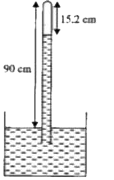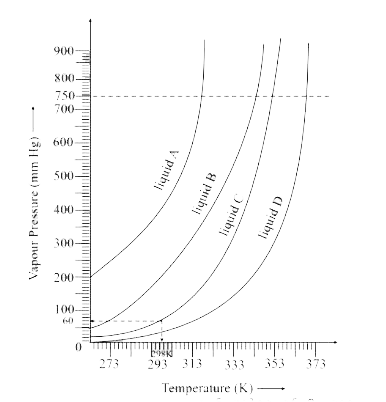The atmospheric pressure on Mars is o.61 kPa. What is the pressure in mm Hg?
0.63
4.6
6.3
3.2
The correct Answer is:b
To convert the atmospheric pressure on Mars from kilopascals (kPa) to millimeters of mercury (mm Hg), follow these steps:
1. Understand the Conversion Factors:
- 1 mm Hg is equivalent to 133.322 Pa (Pascals).
- 1 kPa is equal to 1000 Pa.
2. Convert kPa to Pa:
- Given atmospheric pressure on Mars = 0.61 kPa.
- Convert kPa to Pa:
0.61 kPa=0.61×1000 Pa=610 Pa
3. Convert Pa to mm Hg:
- Use the conversion factor:
1 mm Hg=133.322 Pa
- To find the pressure in mm Hg, use the formula:
Pressure in mm Hg=Pressure in PaPa per mm Hg=610 Pa133.322 Pa/mm Hg
4. Perform the Calculation:
- Calculate the above expression:
Pressure in mm Hg=610133.322≈4.58 mm Hg
5. Round to Appropriate Significant Figures:
- The result can be rounded to 4.6 mm Hg.
Final Answer:
The atmospheric pressure on Mars is approximately 4.6 mm Hg.
---
- 1 mm Hg is equivalent to 133.322 Pa (Pascals).
- 1 kPa is equal to 1000 Pa.
- Given atmospheric pressure on Mars = 0.61 kPa.
- Convert kPa to Pa:
0.61 kPa=0.61×1000 Pa=610 Pa
- Use the conversion factor:
1 mm Hg=133.322 Pa
- To find the pressure in mm Hg, use the formula:
Pressure in mm Hg=Pressure in PaPa per mm Hg=610 Pa133.322 Pa/mm Hg
- Calculate the above expression:
Pressure in mm Hg=610133.322≈4.58 mm Hg
- The result can be rounded to 4.6 mm Hg.
The atmospheric pressure on Mars is approximately 4.6 mm Hg.
Topper's Solved these Questions
- BOOK - NARENDRA AWASTHI ENGLISHCHAPTER - GASEOUS STATEEXERCISE - Level 230videos
GASEOUS STATE
- BOOK - NARENDRA AWASTHI ENGLISHCHAPTER - GASEOUS STATEEXERCISE - Level 3 Passage 14videos
GASEOUS STATE
- BOOK - NARENDRA AWASTHI ENGLISHCHAPTER - ELECTROCHEMISTRYEXERCISE - Subjective problems14videos
ELECTROCHEMISTRY
- BOOK - NARENDRA AWASTHI ENGLISHCHAPTER - IONIC EEQUILIBRIUMEXERCISE - Subjective problems1videos
IONIC EEQUILIBRIUM
Similar Questions
A cylinder contains 0.3 moles of N2, 0.1 mole of O2 and 0.1 mole of helium. If the total pressure is one atm, what is the partial pressure
of oxygen in mm Hg:-View SolutionAt sea level, the atmospheric pressure is 76 cm of Hg. If air pressure falls by 10 mm of Hg per 120 m of ascent, what is the height of a hill where the barometer reads 70 cm Hg.
View Solution
Knowledge Check
- Question 1 - Select One
If the systolic pressure is 120 mm Hg and diastolic pressure is 80 mm Hg, the pulse pressure is _____
A120 × 80= 9600 mm HgB120+80=200 mm HgC120-80=40 mm HgD120/80=1.5 mm Hg. - Question 2 - Select One
If the systolic pressure is 120 mm Hg and diastolic pressure is 80 mm Hg, the pulse pressure is _______
A120 × 80= 9600 mm HgB120+80=200 mm HgC120-80=40 mm HgD120/80=1.5 mm Hg.
At sea level, the atmospheric pressure is 76 cm of Hg. If air pressure falls by 10 mm of Hg per 120 m of ascent, what is the height of a hill where the barometer reads 70 cm Hg. State the assumption made by you. .
View SolutionBoiling point of a mixture of water and nitrobenzene is 99∘C, the vapour pressure of water is 733mm of Hg and the atmospheric pressure is 760nn if Hg. The molecular weight of nitrobenzene is 123. Find the ratio weights of the components of the distillate.
View SolutionWhat is meant by the statement “the atmospheric pressure at a place is 76 cm of Hg"? State its value in Pa.
View SolutionThe length of a faulty barometer is 90 cm and there is a little air above the mercury. When the atmospheric pressure is 76cm of Hg it reads 74.8 cm. What will be the true atmospheric pressure if the reading on the barometer is 74.3cm ?
 View Solution
View SolutionThe variation of vapour pressure of different liquids with temperature is shown in figure

At high altitude, atmospheric pressure is low (say 60 mm Hg). At what temperature liquid D boils?View SolutionAt 35∘C , the vapour pressure of CS2 is 512 mm Hg and that of acetone is 344 mm Hg . A solution of CS2 in acetone has a total vopour pressure of 600 mm Hg. The false statement amongst the following is
View Solution

